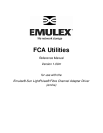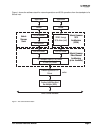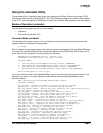
FCA Utilities Reference Manual Page 1
Introduction
This document provides the information needed to use the Emulex® emlxadm and elmxdrv utility
programs. For system administrators, this document includes information about the installation and
removal of these utilities.
At the very least, system administrators should be familiar with Solaris and the Sun StorEdge SAN
Foundation Software (SFS) and should have access to standard system documentation. Anyone
working with this product should have some familiarity with the nature and use of Fibre Channel.
Fibre Channel Overview
Fibre Channel is a general-purpose, high-throughput, low-latency interconnect. It employs serial bit
transmission over copper media, short-wave and long-wave optical media. Cable distances may range
up to 30 meters for copper media and up to 10 kilometers for optical media. Transmission speeds
currently range up to 4 gigabits per second, or roughly 400 megabytes per second. Fibre Channel
transmission protocols provide high reliability, with bit error rates less than 1 in 10
-12
. Interconnects may
be configured as point-to-point, loop, or fabric (network switch).
The Fibre Channel specifications provide for the emulation of two traditional protocols: SCSI and IP. For
storage, Fibre Channel provides an emulation of SCSI; this emulation is dubbed FCP, short for Fibre
Channel Protocol – a confusing acronym, in that it refers specifically to SCSI-on-Fibre Channel rather
than to the lower-level protocols by which Fibre Channel itself operates. Throughout this document, we
generally refer to FCP; when we mention SCSI, we are referring to the particular SCSI properties within
FCP, or to the original SCSI protocol. For networking, Fibre Channel provides an encapsulation of IP
(Internet Protocol), referred to in this document as IP.
The Solaris Fibre Channel Stack
Each Fibre Channel host bus adapter (HBA) is managed by an associated device driver. A device driver
acts as a translator between an operating system and the hardware so that the operating system's
kernel need not know the specifics of the device it uses. A device driver contains all of the code specific
to operating a device and provides an input/output (I/O) interface to the rest of the system.
The Emulex-Sun LightPulse® HBA device driver for Solaris, emlxs, is a Fibre Channel adapter (FCA)
driver as specified by the Sun Fibre Channel architecture (also known as Leadville). The heart of the
Sun Fibre Channel architecture consists of the Fibre Channel transport layer (FCTL) modules, which
provide a common interface for various Fibre Channel adapters on a host. These modules consist of
several tightly coupled pieces, including a per-port driver (FP) and a system-wide transport layer (FCTL)
driver. The FP driver handles all per-port state and common services needed by a variety of protocols
and the FCA drivers. The FCTL module provides consistent, system-wide access of Fibre Channel
devices and services to upper layer protocols (ULP) and administration utilities. The point of providing a
Fibre Channel port/transport interface is to abstract and define all services available through an FCA
driver needed by FC-4 ULP drivers such as the SCSI driver (FCP) and the IP driver (FCIP). The FCP
function provides access to Fibre Channel disk and tape drives. The IP function provides peer-to-peer
networking, such as TCP or UDP, between Fibre Channel hosts.


















